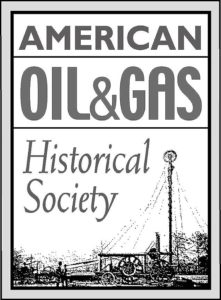by Bruce Wells | Apr 7, 2025 | This Week in Petroleum History
April 7, 1902 – Spindletop Boom brings The Texas Company –
Joseph “Buckskin Joe” Cullinan and Arnold Schlaet established The Texas Company in Beaumont to transport and refine oil from Spindletop Hill, a giant oilfield discovered in January 1901. The new company constructed a kerosene refinery in Port Arthur — and discovered an oilfield at Sour Lake Springs, where its Fee No. 3 well produced 5,000 barrels of oil a day in 1903.

The National Route 66 Museum in Elk City, Oklahoma, preserves the heritage of Texaco, the first petroleum company to market products in all 50 states. Photo by Bruce Wells.
The Texas Company telegraph address at its New York office was “Texaco,” a name soon adopted for its petroleum products. In 1909 a red star with a green capital “T” was trademarked and by 1928 the Texaco brand operated more than 4,000 service stations nationwide. The Texas Company, which officially renamed itself Texaco in 1959, was acquired by Chevron in 2001.
Learn more in Sour Lake produces Texaco.

April 7, 1966 – Cold War Accident boosts Offshore Technology
A robotic technology soon adopted by the offshore petroleum industry was first used to retrieve an atomic bomb. America’s first cable-controlled underwater research vehicle (CURV) attached cables to recover the weapon lost in the Mediterranean Sea.
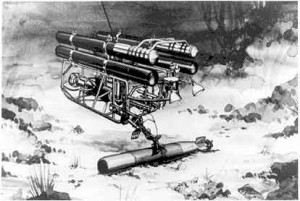
The U.S. Navy in 1966 used its CURV (Cable-Controlled Underwater Recovery Vehicle) to recover a lost nuclear bomb in the Mediterranean.
The 70-kiloton hydrogen bomb, which had been lost when a B-52 crashed off the coast of Spain in January, was safely hoisted from a depth of 2,850 feet.
“It was located and fished up by the most fabulous array of underwater machines ever assembled,” proclaimed Popular Science magazine. During the Cold War, the Navy developed deep-sea technologies that the offshore petroleum industry would adopt and continue to advance.
Learn more in ROV – Swimming Socket Wrench.
April 8, 1929 – Sinclair vs. United States
The Supreme Court unanimously upheld a lower court ruling that Congress had the right to investigate Sinclair Oil founder Harry Sinclair’s personal dealings with Secretary of the Interior Albert Fall regarding the leasing of federal oil reserves. In 1922, Fall had leased land in the Teapot Dome oilfield (Navy Reserve No. 3) to the Mammoth Oil Company, a Sinclair subsidiary. He also leased land in California’s Elk Hills reserve to Edward Doheny, the 1892 discoverer of the Los Angeles Field.
After several trials, proceedings concluded with Doheny being acquitted of conspiracy and Fall convicted of accepting bribes and serving nine months in prison, notes the Federal Judicial Center. He was the first cabinet official to go to prison. Sinclair was acquitted of conspiracy but convicted of contempt of Congress and served six and a half months in prison in 1929.
April 9, 1914 – Ohio Cities Gas Company founded
Beman Dawes and Fletcher Heath organized the Ohio Cities Gas Company in Columbus, Ohio, before building an oil refinery in West Virginia. Ohio Cities Gas acquired Pennsylvania-based Pure Oil Company in 1917 and adopted that name three years later. Pure Oil was founded in Pittsburgh in 1895 by independent oil producers, refiners, and pipeline operators to counter the market dominance of Standard Oil Company.
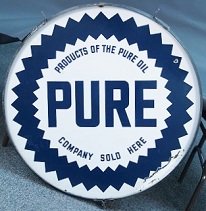
Ohio Cities Gas Company became Pure Oil in 1917.
By producing, refining and selling its products, Pure Oil became the second vertically integrated petroleum company after Standard Oil. Headquartered in a now iconic Chicago skyscraper it built in 1926, the company joined the 100 largest U.S. industrial corporations. It was acquired in 1965 by Union Oil Company of California, now a division of Chevron.
April 9, 1966 – Birthday of Tula’s Golden Driller
A 76-foot statue of an oilfield worker today known as “The Golden Driller” made its debut at the International Petroleum Exposition in Tulsa, Oklahoma. After several refurbishments, the 22-ton statue would contain 2.5 miles of rods and mesh with tons of plaster and concrete — withstanding winds up to 200 mph. A smaller version of Tulsa’s iconic roughneck originally appeared at the 1953 petroleum exposition as a promotion for the Mid-Continent Supply Company of Fort Worth, Texas.
April 10, 1866 – Densmore Brothers patent Railroad Oil Tank Car
James and Amos Densmore of Meadville, Pennsylvania, received a patent for their “Improved Car for Transporting Petroleum,” developed a year earlier in the northwestern Pennsylvania oil regions. Their patent illustrated a simple but sturdy design for securing two re-enforced containers on a typical railroad car.

The Densmore dual tank car briefly revolutionized the bulk transportation of oil to market. Hundreds of the twin tank railroad cars were in use by 1866.
Although the Densmore cars were an improvement, they would be replaced by the more practical single, horizontal tank. After leaving the business, Amos Densmore in 1875 invented a new way for arranging “type writing machines” so commonly used letters would not collide — the “Q-W-E-R-T-Y” keyboard. James Densmore’s continued success in oilfields helped finance the start of the Densmore Typewriter Company.
Learn more in Densmore Brothers invent First Oil Tank Car.
April 11, 1957 – Independent Producer William Skelly dies
William Grove Skelly (1878 -1957) died in Tulsa after a long career as an independent producer he began as a 15-year-old tool dresser in early Pennsylvania oilfields. Prior to World War I, he found success in the El Dorado field outside Wichita, Kansas. Skelly incorporated Skelly Oil Company in Tulsa in 1919. In 1923, Skelly organized the first International Petroleum Exposition while serving as president of the Tulsa Chamber of Commerce. Skelly in 1947 helped establish KWGS, Tulsa’s first FM radio station and one of the earliest educational stations in the nation.

April 13, 1974 – Depth Record set in Oklahoma Anadarko Basin
After drilling for 504 days and spending about $7 million, the Bertha Rogers No. 1 well reached a total depth of 31,441 feet (5.95 miles) before being stopped by liquid sulfur. Drilled in Oklahoma’s Anadarko Basin, it held the record of the world’s deepest well for more than a decade.
The GHK Company of Robert Hefner III and partner Lone Star Producing Company believed natural gas reserves resided deep in the Anadarko Basin extending across West-Central Oklahoma and the Texas Panhandle. Their first high-tech drilling attempt began in 1967 and took two years to reach a then record depth of 24,473 feet.

A 1974 souvenir plaque of the Bertha Rogers No. 1 well, which reached almost six miles deep in Oklahoma’s Anadarko Basin.
The 1969 well found plenty of natural gas, according to historian Robert Dorman, but because of federal price controls, “the sale of the gas could not cover the high cost of drilling so deeply – $6.5 million, as opposed to a few hundred thousand dollars for a conventional well.”
The drilling of the Bertha Rogers well began in November 1972 and averaged about 60 feet per day. By April 1974, bottom-hole pressure reached almost 25,000 pounds per square inch with a temperature of 475 degrees. The well’s 1.5 million pounds of casing was the heaviest ever handled by a drilling rig, and it took eight hours for cuttings to reach the surface.
Learn more in Anadarko Basin in Depth.
_______________________
Recommended Reading: The Texaco Story: The First Fifty Years, 1902-1952 (2012); Mapping the Deep: The Extraordinary Story of Ocean Science
(2012); Mapping the Deep: The Extraordinary Story of Ocean Science (2002); Diving & ROV: Commercial Diving offshore (2021); The American Railroad Freight Car (1995); Story of the Typewriter, 1873-1923 (2019); Tulsa Where the Streets Were Paved With Gold – Images of America
(2002); Diving & ROV: Commercial Diving offshore (2021); The American Railroad Freight Car (1995); Story of the Typewriter, 1873-1923 (2019); Tulsa Where the Streets Were Paved With Gold – Images of America (2000); Oil in Oklahoma
(2000); Oil in Oklahoma (1976); History Of Oil Well Drilling
(1976); History Of Oil Well Drilling (2007). Your Amazon purchase benefits the American Oil & Gas Historical Society. As an Amazon Associate, AOGHS earns a commission from qualifying purchases.
(2007). Your Amazon purchase benefits the American Oil & Gas Historical Society. As an Amazon Associate, AOGHS earns a commission from qualifying purchases.
_______________________
The American Oil & Gas Historical Society (AOGHS) preserves U.S. petroleum history. Please become an AOGHS annual supporter and help maintain this energy education website and expand historical research. For more information, contact bawells@aoghs.org. Copyright © 2025 Bruce A. Wells. All rights reserved.
by Bruce Wells | Jan 6, 2025 | This Week in Petroleum History
January 7, 1864 – Oilfield Discovery at Pithole Creek –
The once famous Pithole Creek oilfield was discovered in Pennsylvania with the United States Petroleum Company’s well reportedly located using a witch-hazel dowser. The discovery well, which initially produced 250 barrels of oil a day, brought a “black gold” rush as boom town Pithole made headlines five years after the first U.S. oil well drilled at nearby Titusville.
oilfield was discovered in Pennsylvania with the United States Petroleum Company’s well reportedly located using a witch-hazel dowser. The discovery well, which initially produced 250 barrels of oil a day, brought a “black gold” rush as boom town Pithole made headlines five years after the first U.S. oil well drilled at nearby Titusville.
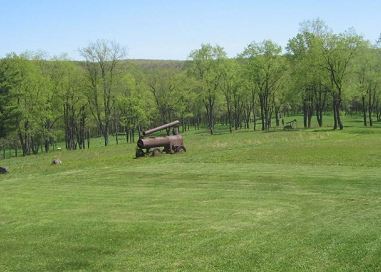
Boom town Pithole City’s history is preserved at Pennsylvania’s Oil Creek State Park. Photo by Bruce Wells.
Adding to the boom were Civil War veterans eager to invest in the new industry. Newspaper stories added to the oil fever — as did the Legend of “Coal Oil Johnny.” Tourists today visit Oil Creek State Park and its education center on the grassy expanse that was once Pithole.
January 7, 1905 – Humble Oilfield Discovery rivals Spindletop
C.E. Barrett discovered the Humble oilfield in Harris County, Texas, with his Beatty No. 2 well, which brought another Texas drilling boom four years after Spindletop launched the modern petroleum industry. Barrett’s well produced 8,500 barrels of oil per day from a depth of 1,012 feet.
The population of Humble jumped from 700 to 20,000 within months as production reached almost 16 million barrels of oil, the largest in Texas at the time. The field directly led to the 1911 founding of the Humble Oil Company by a group that included Ross Sterling, a future governor of Texas.
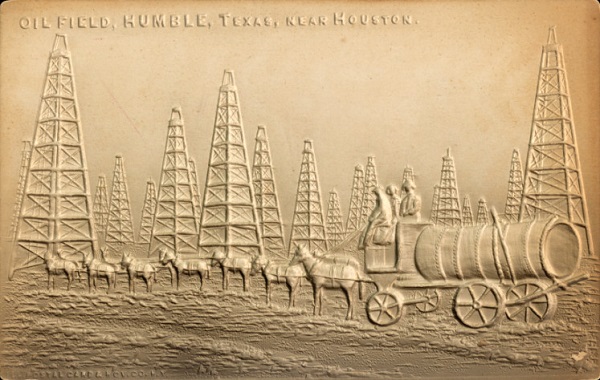
An embossed postcard circa 1905 from the Postal Card & Novelty Company, courtesy the University of Houston Digital Library.
“Production from several strata here exceeded the total for fabulous Spindletop by 1946,” notes a local historic marker. “Known as the greatest salt dome field, Humble still produces and the town for which it was named continues to thrive.” Another giant oilfield discovery in 1903 at nearby Sour Lake helped establish the Texaco Company.
Humble Oil, renamed Humble Oil and Refining Company in 1917, consolidated operations with Standard Oil of New Jersey two years later, eventually leading to ExxonMobil.

January 7, 1957 – Michigan Dairy Farmer finds Giant Oilfield
After two years of drilling, a wildcat well on Ferne Houseknecht’s Michigan dairy farm discovered the state’s largest oilfield. The 3,576-foot-deep well produced from the Black River formation of the Trenton zone.
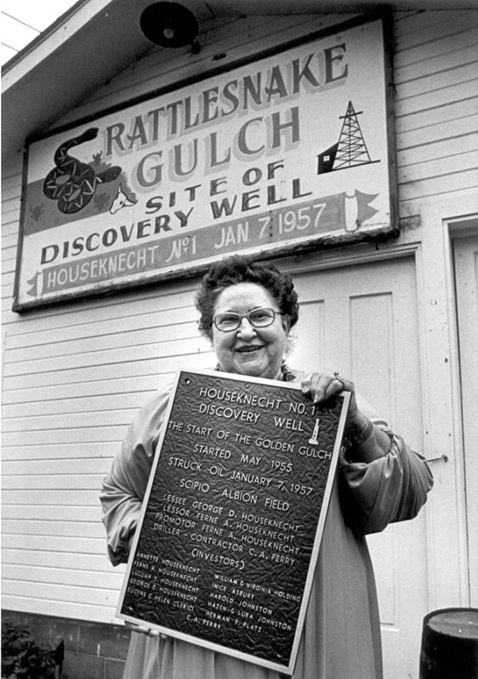
After 20 months of on-again, off-again drilling, Ferne Houseknecht’s well revealed a giant oilfield in the southern Michigan basin.
The Houseknecht No. 1 discovery well at Rattlesnake Gulch revealed a producing region 29 miles long and more than one mile wide. It prompted a drilling boom that led to production of 150 million barrels of oil and 250 billion cubic feet of natural gas from the giant Albion-Scipio field in the southern Michigan basin.
“The story of the discovery well of Michigan’s only ‘giant’ oilfield, using the worldwide definition of having produced more than 100 million barrels of oil from a single contiguous reservoir, is the stuff of dreams,” noted Michigan historian Jack Westbrook in 2011.
in 2011.
Learn more in Michigan’s “Golden Gulch” of Oil.
January 7, 1913 – “Cracking” Patent improves Refining
William Burton of the Standard Oil Company’s Whiting, Indiana, refinery received a patent for a process that doubled the amount of gasoline produced from each barrel of oil refined. Burton’s invention came as gasoline demand was rapidly growing with the popularity of automobiles. His thermal cracking concept was an important refining advancement, although the process would be superseded by catalytic cracking in 1937.
January 8, 1903 – Sour Lake discovery leads to Texaco
Founded a year earlier in Beaumont, Texas, the Texas Company struck oil with its Fee No. 3 well, which flowed at 5,000 barrels a day, securing the company’s success in petroleum exploration, production, transportation and refining.

A monument marks the site where the Fee No. 3 well flowed at 5,000 barrels of oil a day in 1903, helping the Texas Company become Texaco.
“After gambling its future on the site’s drilling rights, the discovery during a heavy downpour near Sour Lake’s mineral springs, turned the company into a major oil producer overnight, validating the risk-taking insight of company co-founder J.S. Cullinan and the ability of driller Walter Sharp,” explained a Texaco historian. The Sour Lake field — and wells drilled in the Humble oilfield two years later — led to the Texas Company becoming Texaco (acquired by Chevron in 2001).
Learn more in Sour Lake produces Texaco.

January 10, 1870 – Rockefeller incorporates Standard Oil Company
John D. Rockefeller and five partners incorporated the Standard Oil Company in Cleveland, Ohio. The new oil and refining venture immediately focused on efficiency and growth. Instead of buying barrels, the company bought tracts of oak timber, hauled the dried timber to Cleveland on its own wagons, and built its own 42-gallon oil barrels.
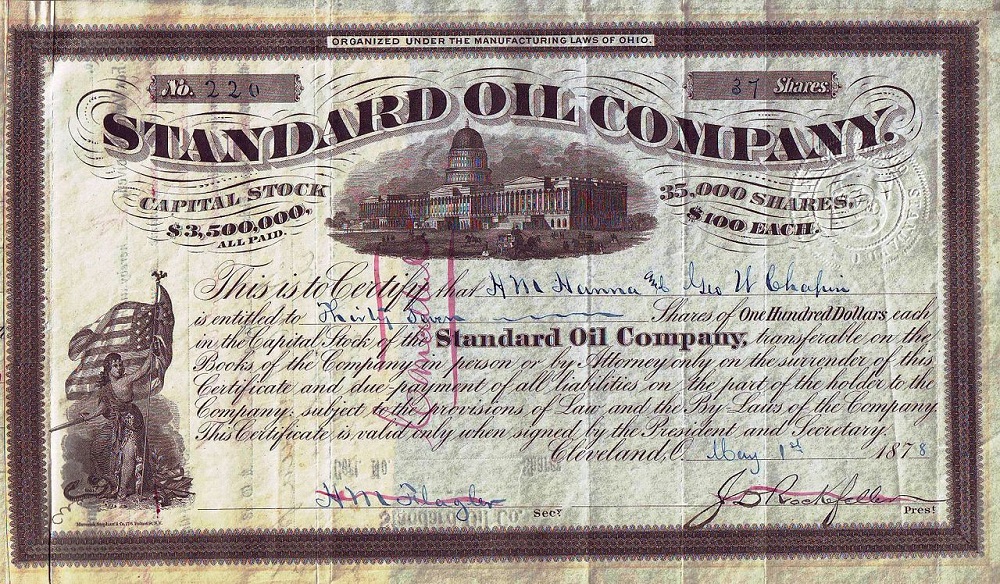
A stock certificate issued in 1878 for Standard Oil Company, which would become Standard Oil of Ohio (Sohio) following the 1911 breakup of John D. Rockefeller’s oil monopolies.
Standard Oil’s cost per wooden barrel dropped from $3 to less than $1.50 as the company improved refining methods to extract more kerosene per barrel of oil (there was no market for gasoline). By purchasing properties through subsidiaries, dominating railroads and using local price-cutting, Standard Oil captured 90 percent of America’s refining capacity.
January 10, 1901 – Spindletop launches Modern Petroleum Industry
The modern U.S. oil and natural gas industry began 123 years ago on a small hill in southeastern Texas when a wildcat well erupted near Beaumont. The Spindletop field, which yielded 3.59 million barrels of oil by the end of 1901, would produce more oil in one day than all the rest of the world’s oilfields combined.

The Spindletop-Gladys City Boomtown Museum in Beaumont, Texas, opened in 1976 to educate visitors about the importance of the 1901 “Lucas Gusher.”
The “Lucas Gusher” and other nearby discoveries changed American transportation by providing abundant oil for cheap gasoline. The drilling boom would bring hope to a region devastated just a few months earlier by the Galveston Hurricane, still the deadliest in U.S. history. Petroleum production from the well’s geologic salt dome had been predicted by Patillo Higgins, a self-taught geologist and Sunday school teacher.
Learn more in Spindletop launches Modern Petroleum Industry.
January 10, 1919 – Elk Hills Oilfield discovered in California
Standard Oil of California discovered the Elk Hills field in Kern County, and the San Joaquin Valley soon ranked among the most productive oilfields in the country. It became embroiled in the 1920s Teapot Dome lease scandals and yielded its billionth barrel of oil in 1992. Visit the petroleum exhibits of the Kern County Museum in Bakersfield and at the West Kern Oil Museum in Taft.

January 10, 1921 – Oil Boom arrives in Arkansas
“Suddenly, with a deafening roar, a thick black column of gas and oil and water shot out of the well,” noted one observer in 1921 when the Busey-Armstrong No. 1 well struck oil near El Dorado, Arkansas. H.L. Hunt would soon arrive from Texas (with $50 he had borrowed) and join lease traders and speculators at the Garrett Hotel — where fortunes were soon made and lost. “Union County’s dream of oil had come true,” reported the local paper. The giant Arkansas field would lead U.S. oil output in 1925 with production reaching 70 million barrels.
Learn more in First Arkansas Oil Wells.
January 11, 1926 – “Ace” Borger discovers Oil in North Texas
Thousands rushed to the Texas Panhandle seeking oil riches after the Dixon Creek Oil and Refining Company completed its Smith No. 1 well, which flowed at 10,000 barrels a day in southern Hutchinson County. A.P. “Ace” Borger of Tulsa, Oklahoma, had leased a 240-acre tract. By September, the Borger oilfield was producing more than 165,000 barrels of oil a day.
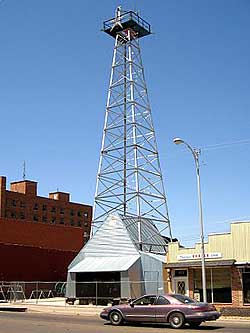
A downtown museum exhibits Borger’s oil heritage. Photo by Bruce Wells.
After establishing his Borger Townsite Company, Borger laid out streets and sold lots for the town, which grew to 15,000 residents in 90 days. When the oilfield produced large amounts of natural gas, the town named its minor league baseball team the Borger Gassers. The team left the league in 1955 (owners blamed air-conditioning and television for reducing attendance).
Dedicated in 1977, the Hutchinson County Boom Town Museum in Borger celebrates “Oil Boom Heritage” every March.
January 12, 1904 – Henry Ford sets Speed Record
Seeking to prove his cars were built better than most, Henry Ford set a world land speed record on a frozen Michigan lake. At the time his Ford Motor Company was struggling to get financial backing for its first car, the Model T. It was just four years after America’s first auto auto show.
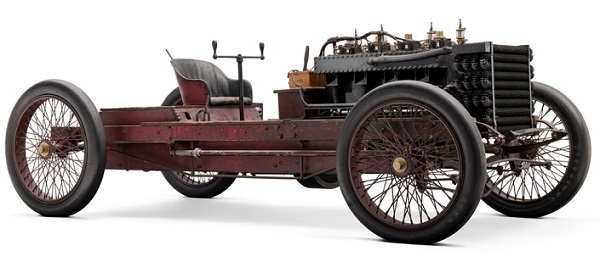
The Ford No. 999 used an 18.8 liter inline four-cylinder engine to produce up to 100 hp. Image courtesy Henry Ford Museum.
Ford drove his No. 999 Ford Arrow across Lake St. Clair, which separates Michigan and Ontario, Canada, at a top speed of 91.37 mph. The frozen lake “played an important role in automobile testing in the early part of the century,” explained Mark DIll in “Racing on Lake St. Clair” in 2009. “Roads were atrocious and there were no speedways.”
Learn about a 1973 natural gas-powered world land speed record in Blue Flame Natural Gas Rocket Car.

January 12, 1926 – Texans patent Ram-Type Blowout Preventer
Seeking to end dangerous and wasteful oil gushers, James Abercrombie and Harry Cameron patented a hydraulic ram-type blowout preventer (BOP). About four years earlier, Abercrombie had sketched out the design on the sawdust floor of Cameron’s machine shop in Humble, Texas. Petroleum companies embraced the new technology, which would be improved in the 1930s.

James Abercrombie’s design used hydrostatic pistons to close on the drill stem. His improved blowout preventer set a new standard for safe drilling
First used during the Oklahoma City oilfield boom, the BOP helped control production of the highly pressurized Wilcox sandstone (see World-Famous “Wild Mary Sudik”). The American Society of Mechanical Engineers recognized the Cameron Ram-Type Blowout Preventer as an “Historic Mechanical Engineering Landmark” in 2003.
Learn more in Ending Oil Gushers – BOP.
_______________________
Recommended Reading: Myth, Legend, Reality: Edwin Laurentine Drake and the Early Oil Industry (2009); Humble, Images of America (2013); Michigan Natural Resources Trust Fund 1976-2011: A 35-year Michigan Oil and Gas Industry Investment Heritage in Michigan’s Public Recreation Future
(2013); Michigan Natural Resources Trust Fund 1976-2011: A 35-year Michigan Oil and Gas Industry Investment Heritage in Michigan’s Public Recreation Future (2011); Handbook of Petroleum Refining Processes
(2011); Handbook of Petroleum Refining Processes (2016); Black Gold in California: The Story of California Petroleum Industry (2016); Titan: The Life of John D. Rockefeller, Sr.
(2016); Black Gold in California: The Story of California Petroleum Industry (2016); Titan: The Life of John D. Rockefeller, Sr. (2004); Giant Under the Hill: A History of the Spindletop Oil Discovery at Beaumont, Texas, in 1901
(2004); Giant Under the Hill: A History of the Spindletop Oil Discovery at Beaumont, Texas, in 1901 (2008); Early Louisiana and Arkansas Oil: A Photographic History, 1901-1946
(2008); Early Louisiana and Arkansas Oil: A Photographic History, 1901-1946 (1982); I Invented the Modern Age: The Rise of Henry Ford
(1982); I Invented the Modern Age: The Rise of Henry Ford (2014); Drilling Technology in Nontechnical Language
(2014); Drilling Technology in Nontechnical Language (2012). Your Amazon purchase benefits the American Oil & Gas Historical Society. As an Amazon Associate, AOGHS earns a commission from qualifying purchases.
(2012). Your Amazon purchase benefits the American Oil & Gas Historical Society. As an Amazon Associate, AOGHS earns a commission from qualifying purchases.
_______________________
The American Oil & Gas Historical Society (AOGHS) preserves U.S. petroleum history. Please become an AOGHS annual supporter and help maintain this energy education website and expand historical research. For more information, contact bawells@aoghs.org. Copyright © 2025 Bruce A. Wells. All rights reserved.




(2012); Mapping the Deep: The Extraordinary Story of Ocean Science
(2002); Diving & ROV: Commercial Diving offshore (2021); The American Railroad Freight Car (1995); Story of the Typewriter, 1873-1923 (2019); Tulsa Where the Streets Were Paved With Gold – Images of America
(2000); Oil in Oklahoma
(1976); History Of Oil Well Drilling
(2007). Your Amazon purchase benefits the American Oil & Gas Historical Society. As an Amazon Associate, AOGHS earns a commission from qualifying purchases.













